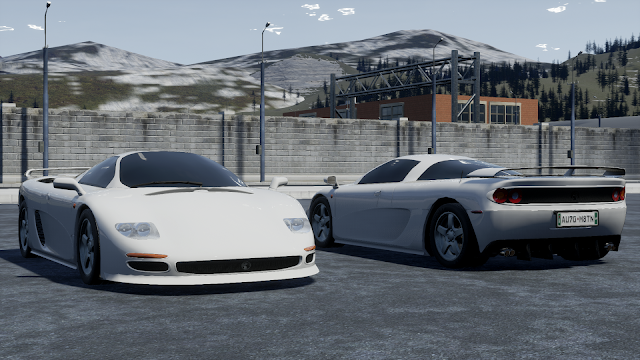Confessions of an Automationeer, Part 98: The New Golden Age of the Hampton Motor Group
Conceived just prior to company founder Toby Hampton's retirement (which paved the way for his son Tony to take over the helm), the Hampton Motor Group's large-scale modernization and reorganization plan during the 1990s was an immensely ambitious, expensive and time-consuming endeavor. While it certainly yielded some impressive machinery, this plan did not come without its problems. In particular, some highly anticipated models, or variants thereof, ended up going on sale up to five years later than expected. But when they finally did arrive, they all proved to be well worth the wait - and buyers eagerly snapped them up in droves. To reflect the more optimistic mood of the new decade, many of these cars would also be offered in brighter, more saturated hues compared to their predecessors.
Above, from top: 1991 all-new Hampton range - Vanguard, Fennec, Valiant, Venator and Braemar.
Among the many new or revised models Hampton introduced during the early 1990s were the all-new entry-level Fennec, full-sized Valiant, and flagship Vanguard, with the last of these also spawning a two-door coupe and convertible called the Venator. Nothing was carried over from their predecessors - not even the engines. While this made them more expensive to develop and build, the extra money spent paid off in dynamics, comfort, economy and refinement. The rest of the core range, meanwhile, also received new engines to keep them competitive until they could finally be properly replaced. This included their pick-up truck, the Nevis; it even begat an SUV derivative, called the Braemar, which was built on the same platform.
Above, from top: Updated carryover models for Hampton for 1991 - Transliner, Ferret, Transtar and Nevis.
In addition to this, Hampton's newly rebranded performance arm, Hampton Performance & Racing, managed to launch four new models during this time. The much-anticipated Sprint variants of the new Fennec and Valiant debuted in 1992, but more significantly, they also managed to introduce two dedicated sports cars - the Vulture, an affordable mid-engined four-cylinder coupe, and the Hawk, a more upmarket front-engined muscle car powered by a high-displacement V8 engine. The latter replaced the Peregrine II, which had served the brand well during the 1980s but was at risk of being outclassed by its key rivals after 1990. However, there would be even more to come from this high-performance skunk works in the years that followed.
Above, clockwise from top left: 1992 Hampton Performance & Racing lineup - Vulture 1.8, Valiant 5.0 Sprint, Vulture 2.0 Sprint, Fennec 1.8 Sprint, and Hawk GT 5.0.
In anticipation of the company's 50th anniversary, HPR had developed an even faster and more exclusive machine - the Hydra. With all-carbon construction, pushrod-actuated suspension and a highly tuned V12 engine, this was not only Hampton's fastest car ever, but also their most advanced, exclusive and expensive offering to date. 50 cars were built from 1993 to 1998; although HPR lost money on every one they sold, the many lessons learned during its development, especially on the use of advanced lightweight materials, were most definitely worth it.
Above: 1993 Hampton Hydra in Bright Yellow - the first hypercar ever made by Hampton, and its fastest car to date. Below: 1995 Hydra LM - one of five built, and the Holy Grail for all Hampton collectors worldwide.
Keen to keep the momentum going, Tony decided that a sizable portion of the range should receive a redesign around 1994-96, with other models being updated around the same time to keep them competitive. To that end, he approved an update to the entry-level Fennec, an all-new fifth-generation Ferret, a revised version of the Braemar SUV, and a redesigned Transliner, still a five- or seven-seater as before (depending on spec), but now with a much sleeker body. On top of that, he wanted everything else in the range to be updated (including dedicated sports cars such as the Vulture and Hawk) if possible. It was as ambitious an undertaking as launching the new models themselves had been, but as before, he was confident that it would turn out very well in the end - and he would soon be proven right.
Above, clockwise from top: Selected cars from the 1996 Hampton model range - Braemar 4x4 2.8i, Fennec 1.8i 5-door, Vulture 1.8i Performance, and Ferret MkV 2.5 Prime.
The new Ferret was one of the few completely new cars in the second phase of Hampton's expansion plan; most of the others were updates of existing models. In any case, this range-wide overhaul helped maintain the brand's competitiveness in an increasingly crowded market. Nor had Hampton Performance & Racing been standing still. They added a more focused and powerful (by 20 horsepower) GTS trim to the Hawk range, and developed an even crazier version of the Hydra, called the LM, of which just five examples were made - 10% of the total production run. The standard Vulture, meanwhile, gained a Performance Pack option, which included high-performance tires, wider-diameter wheels, a limited-slip differential, and uprated brakes and suspension - the flagship version, on the other hand, was now called the SuperSprint, and received an extra 10 horsepower, for a total of 200. Even the Venator would be updated; when the Vanguard received new engines during 1995/96, so did the Venator.
A Hampton Transliner II 1.8 Prime in Emerald Metallic, showing its new, sleek design that made its predecessor seem very dated indeed.
By 1995, HPR had made all its hard work pay off; when Straight 6 Magazine (a fictional publication) compared the Hawk GTS with the Katsuro Vatina and TDF SS38iS (two of the Hawk's main competitors, especially the former), they found the Hawk to be more expensive than its rivals, but more fun to drive - and unquestionably easier to live with day-to-day, to boot, thereby making its higher price far easier to justify in the final reckoning.
One of the pictures taken during Straight 6 Magazine's comparison test between the Hampton Hawk GTS, Katsuro Vatina and TDF SS38iS. The Hawk prevailed - but it was a close contest all the way.
And they weren't finished. The Valiant SuperSprint inherited the Hawk's mechanical upgrades for 1995, further cementing its place at the top of the super sedan heap - as it had been for the past few years. Moreover, thanks to their input, the regular Hampton range also benefited from improved economy and performance, with reduced emissions to boot. The customers, naturally, were among the first to reap the benefits of Hampton's work; they simply couldn't get enough of the new model range, and bought them in droves.
Even the off-road and commercial vehicles in the burgeoning line-up would not be neglected. While the Nevis, Transtar and Braemar all got new or revised engines, only the latter would receive a new trim level - specifically, the upmarket Deluxe specification that had been available on their mid-range passenger cars for decades. It was a sure-fire hit among well-heeled buyers who would have wanted a Ferret or Valiant but wanted to take their creature comforts with them as they ventured off-road into the wilderness and back.
By the time the Hampton Motor Group was celebrating its 50th anniversary, it was in its strongest position yet - and with some of its rivals stumbling in certain areas during this time, few dared to dispute the fact that Hampton was one of the world's most successful car companies. Yet they would not rest on their laurels going into the 21st century; to do so would have risk being left behind by their opposition. Therefore, yet another new generation of models would be required - one that would be even more advanced and competitive than their predecessors, just as Tony had promised. To that end, a new set of platforms, bodies and drivetrains would have to be developed, using all the knowledge the company had gained during the past 25 years - no mean feat, but one that Toby believed was well within reach, considering his capabilities.






















































